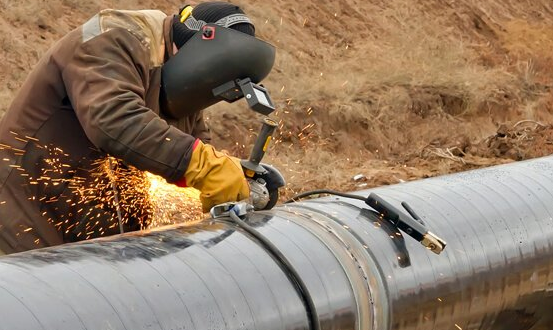
Analysis of Quality Defects in Welded Section of Welded Pipe
Welding seam is an important indicator of the quality of welded pipes (SSAW/LSAW/ERW) and is the life of welded pipes. Therefore, the analysis and treatment of welded section quality defects should be carried out around the welded seam. The main defects of welds include weld cracks, cracks, incomplete penetration, overburning and perforation, and weld misalignment.

1) Weld cracking: including natural weld cracking (including stress corrosion) and stress (additional external force) cracking.
Features: The natural cracking of the weld refers to the cracking of the welded pipe after leaving the squeeze roller. The weld is not cracked due to additional external force in the cooling water tank, sizing machine, warehouse, etc., this type of crack is shaped like a canine tooth and appears gray. The more notable feature of the luster of non-ferrous metals is that it does not require external force and cracks for no reason.
Causes: There are many reasons for the natural cracking of the weld. The main reasons are insufficient extrusion force, too low or too high welding temperature, narrow and thin tube blanks, too deep burr removal, butt welding surface ︿ or reverse ﹀ shape Butt joints and high-strength pipe rings cause excessive forming transverse residual tensile stress, etc.
Measures to prevent natural cracking of welds include:
1. Strictly check raw materials and remove the hard tube blanks.
2. According to different tube blanks, choose a stable welding process to avoid cold welding and over-burning.
3. Strengthen the forming adjustment, reduce the forming residual stress, and realize the parallel butt joint of the welds.
b. Weld cracking under force
Flattening weld cracking includes positive flattening and side flattening cracking. Flattening can be divided into D/3 flattening and full flattening. According to my country's relevant standards, the weld will not crack after D/3 under positive pressure. Qualified, but from the actual use requirements of welded pipes, most of them require full flattening without cracking. The so-called full flattening means 100% pressing down to the inner wall of the pipe with a gap of 0. Full flattening can not only check the welding quality, but also Check the plastic state of the tube blank.
2) Weld cracks
Weld cracks refer to the presence of small hair-like cracks in the weld. Most of these cracks occur in the superficial part of the weld. Some can be seen at a glance, while others need to be carefully identified or even magnified.
Reasons for cracks:
Reflow and slag inclusion caused by high welding temperature, the tube blank is thinner and narrower, and the extrusion force is low. Some oxides are not extruded from the welding seam. After cooling, non-metallic inclusions are formed. Edge micro-cracks, etc., welding seam V-shaped butt, superficial layer fusion structure is loose, cold shrinkage stress will tear the loose structure, the chemical composition of the edge of the tube billet is segregated and the oxide layer is thick, resulting in high melting point non-metallic inclusions, most of which are Cracked welded pipes can pass the hydraulic test, but it is difficult to pass the non-destructive test and the side flattening test. Generally, measures such as increasing the opening angle, increasing the extrusion force, increasing the welding temperature, and improving the edge butt state.3) Dislocation of welds
Weld misalignment refers to the weld formed by two pairs of welding surfaces that are not welded on the same plane. Weld misalignment can be divided into three types: inclined weld misalignment, occasional weld misalignment and periodic weld misalignment, but , They have a common defect feature, that is, after the external burr is normally removed, the external burr still remains on one side of the weld. There are many reasons for seam strength and weld dislocation, including:
1. The first and second flat rolls are asymmetrical when pressed down on both sides
2. The squeeze roller, closed-hole type roller or guide roller has asymmetry, beating, non-concentricity, etc.
3. Forming flat roller bearings, vertical roller bearings, guide roller bearings, squeeze roller bearings, etc. are damaged but have not been found
4. The thickness, width and narrow tolerance of the tube blank are large, S-bend, sickle bend, etc.
5. The tube billet runs unstable and swings from side to side
6. There is an invisible bulge in the formed tube
7. The squeeze roll and guide roll deviate seriously from the rolling center line
The cause of weld dislocation is more complicated. It may be caused by a single cause, or it may be the result of a combination of multiple reasons. The specific search should be based on the principle of easy first and difficult, starting from the visible and tangible reasons, one by one. Eliminate and take corresponding measures.
Tips: ERW welded pipe is formed by rolling strip and welding the seam, with tighter dimensional tolerances and less weight. The weld seam is heat treated after welding that no untempered martensite remains, and the weld flash can be removed from both inner and outer surfaces.


